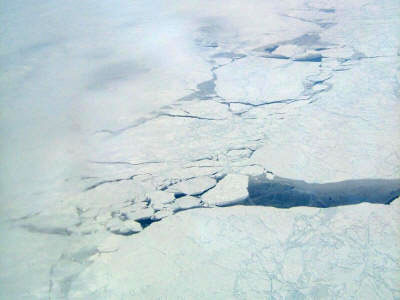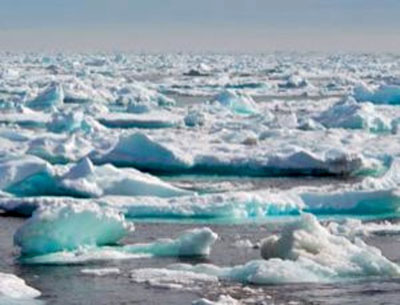|

by Common Dreams
April 22, 2012
from
CommonDreams Website
|
More methane emissions lead
to more warming, and more warming leads to more methane
emissions |
As the Arctic warms due to global warming, the Arctic Ocean itself
may be releasing vast amounts of methane, contributing to even more
global warming, according to a study published today in the journal
Nature Geoscience.

A new airborne study
with NASA contributions measured surprising levels
of the potent
greenhouse gas methane coming from cracks in Arctic sea ice
and areas of partial
sea ice cover.
This image was taken
over the Arctic Ocean at a latitude of approximately
71 degrees North on
April 15, 2010.
(photo: NASA/JPL)
The researchers in the study led by Eric Kort of NASA’s Jet Propulsion Laboratory, Pasadena, Calif., recorded
higher levels of methane above cracks in Arctic sea ice and areas of
partial sea ice cover.
The openings allowed Arctic seawater to
interact with the air and methane in the surface waters to escape
into the atmosphere.
Higher methane readings were not found above
solid ice.
“It’s possible that as large areas
of sea ice melt and expose more ocean water, methane production
may increase, leading to larger methane emissions,” Kort said.
“As Arctic sea ice cover continues to decline in a warming
climate, this source of methane may well increase," he added.
Agence France-Presse:
Arctic Ocean could be source of greenhouse
gas - Study
"We suggest that the surface waters
of the Arctic Ocean represent a potentially important source of
methane, which could prove sensitive to changes in sea-ice
cover," [the study] says.
If so, the Arctic Ocean would add to several identified
"positive feedbacks" in Earth's climate system which ramp up the
greenhouse effect.
One such vicious circle is the release of methane from Siberian
and North American permafrost.
The thawing soil releases methane that has been locked up for
millions of years, which adds to global warming - which in
turns frees more methane, and so on.
But this is the first evidence that points to a methane
contribution from the ocean, not the land, in Arctic latitudes.
NASA:
Study Finds Surprising Arctic
Methane Emission Source
The fragile and rapidly changing
Arctic region is home to large reservoirs of methane, a potent
greenhouse gas.
As Earth’s climate warms, the
methane, frozen in reservoirs stored in Arctic tundra soils or
marine sediments, is vulnerable to being released into the
atmosphere, where it can add to global warming. Now a
multi-institutional study by Eric Kort of NASA’s Jet Propulsion
Laboratory, Pasadena, Calif., has uncovered a surprising and
potentially important new source of Arctic methane: the ocean
itself. [...]
Kort said previous studies by others had measured high
concentrations of methane in Arctic surface waters, but before
now no one had predicted that these enhanced levels of ocean
methane would find their way to the overlying atmosphere.
So how is the methane being produced?
The scientists aren’t yet sure, but
Kort hinted biological production from living things in Arctic
surface waters may be a likely culprit.
“It’s possible that as large
areas of sea ice melt and expose more ocean water, methane
production may increase, leading to larger methane
emissions,” he said.
He said future studies will be
needed to understand the enhanced methane levels and associated
emission processes and to measure their total contribution to
overall Arctic methane levels.
“While the methane levels we
detected weren’t particularly large, the potential source
region, the Arctic Ocean, is vast, so our finding could
represent a noticeable new global source of methane,” he
added.
“As Arctic sea ice cover
continues to decline in a warming climate, this source of
methane may well increase. It’s important that we recognize
the potential contribution from this source of methane to
avoid falsely interpreting any changes observed in Arctic
methane levels in the future.”
Arctic Methane Leaks Threaten Climate
by Michael Marshall
22 April 2012
Magazine issue 2862
from
NewScientist Website
As Arctic sea ice breaks apart, massive
amounts of methane could be released into the atmosphere from the
cold waters beneath. High concentrations of the greenhouse gas have
been recorded in the air above cracks in the ice.
This could be evidence of yet another
positive feedback on the warming climate - leading to even faster
Arctic warming.

Methane released as
ice retreats could force greater climate warming
(Image: KPA/Zuma/Rex
Features)
The Arctic is home to vast stores of
methane - there are billions of
tonnes of methane in permafrost alone.
It is a potent greenhouse gas, so a
major methane release would greatly accelerate climate change. The
gas is found in
icy crystals called hydrates
beneath the shallow seas that flood some areas of the continental
crust, as well as in permafrost.
It is also being released from Arctic
wetlands.
But this doesn't explain why
Eric Kort of the Jet
Propulsion Laboratory in Pasadena, California, and his
colleagues found patches of methane in remote regions of the Arctic
Ocean, far from any of these known methane sources.
The team found the patches during five flights over the Arctic Ocean
between 2009 and 2010, as part of
a project to systematically map greenhouse gas
levels in the atmosphere.
Kort estimates that, in the methane-rich regions, about 2 milligrams
of the gas were being released per square meter of ocean every day.
Some of the patches were close to the
oil and gas plants in Prudhoe Bay, Alaska, but prevailing wind
directions make these plants an unlikely source of the release.
Gassy ocean
So where does the gas come from?
Since the 1970s, scientists have known
that ocean surface waters are rich in methane. It seems to be
made by marine bacteria trying to
survive in waters that don't have many nutrients in the form of
nitrates.
"This source appears to be a likely
candidate to explain what we observed," Kort says.
Water in the Arctic Ocean doesn't mix
well, so the water near the surface tends to remain there.
Consequently,
the methane ends up trapped near the surface.
In other oceans, it would get broken
down through reaction with oxygen or consumed by methanotrophic
bacteria, but the cold weather helps to preserve it.
Kort saw methane releases close to cracks in the sea ice, or in
places where the ice had broken up. This could be because methane
only escapes from agitated water, says
Ellen Damm of the Alfred
Wegener Institute for Polar and Marine Research in Bremerhaven,
Germany.
This agitation is most likely to occur
when autumn sets in and ice crystals start forming in the water,
creating turbulence.
Hotter and hotter
The findings will need to be replicated, says
Euan Nisbet, an earth scientist
at Royal Holloway, University of London.
But if the leak is widespread across the
Arctic, this mechanism could prove to be a significant source of
greenhouse gas.
"We know the Arctic is warming very
fast indeed," Nisbet says.
And as the
warming climate leads to more breaks in the
sea ice, more ice-surrounded patches of open water will
be able to release their methane, further accelerating
global warming.
The question now is: how significant will this new effect on warming
be?
"It might be small," Nisbet says,
"or it could be another serious problem."
Note: Journal
reference:
Nature Geoscience, DOI: 10.1038/ngeo1452
|


